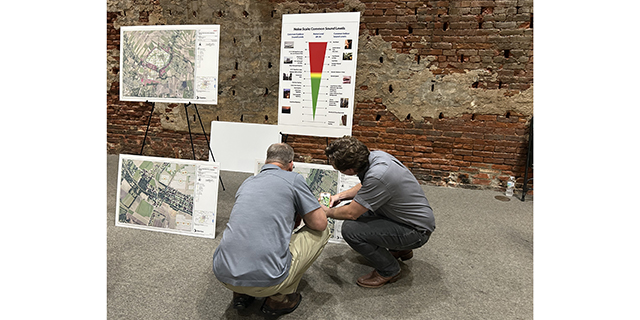California wines
Published 9:40 am Thursday, February 27, 2014

- Todd Faucheaux, from left, Brian Napier and Butch Bourgeois sample a taste of wine at a wine tasting featuring California wines at the Jeanerette Library.
JEANERETTE — Pairing wine with the right food can be complicated, but taking a little time to learn more about wine characteristics, fundamental traits and the proper tasting methods can make the pairing task easier.
Jude Hebert, a third generation wine maker and wine connoisseur, said it is just a matter of getting to know a little about the different types of wines and much of it is about individual taste and personal preference.
“I always say eat what you like, but drink what you love,” said Hebert.
The Jeanerette native was sharing his knowledge of California wines with a group of wine lovers Wednesday at a wine tasting offered by the Jeanerette Library. Hebert provided some history about California wines, tips on pairing food with wine, serving wine, storage and proper methods of tasting.
It’s important to consider the sweetness, acidity, tannins, balance and body of the wine when pairing with foods, he said.
Hebert proved an excellent tasting California wine does not have to come at a high price. He offered samplings of five wines, all ranging from $12 to $33 a bottle that pairs well with a variety of foods and can fit into anyone’s budget.
Ninety percent of the wine made in the United States comes from California grapes, Hebert said.
“We may have a lot of sugar cane here, but there are over 100 different varieties of grapes grown in California,” he said.
Hebert said it is important to serve wine at the right temperature and in the right type of glass.
“This will make a difference as to how the wine will taste,” he said.
Hebert suggested serving a Pinot Noir wine chilled to 55 degrees with lamb, duck, pork or grilled seafood such as tuna steak.
He offered tastings of a La Crema 2011 Pinot Noir Russian River Valley wine in the $18 price range.
“The Russian River Valley vines are made from delicate grapes and is a lighter wine. It should be served in a big bowl glass. The concentrated small berries are bursting with flavor,” he said.
“The type of glass a wine is served in does make a difference.”
A sampling of a Riesling wine from Kendall-Jackson Vintner’s Reserve 2011 of Riesling Monterey County California, which sells between $12 to $15 a bottle, got a nod of approval from Latrelle LaSalle and Beth Shea of New Iberia.
“I’m really into California wines and this is a great opportunity to get to know more about a good bottle of wine. I like the experience of tasting different wines and wanted to get to learn more about the wines from the Russian River Valley,” said LaSalle.
Hebert recommended serving the Vintner’s Reserve 2011 riesling wine with a vinaigrette salad, fried fish or fried soft shell crab. He paired a $25 bottle of Franciscan Estate 2010 Napa Valley Merlot with steak or duck.
The Vintner’s Reserve 2011 offers stone fruit flavors of apricot and peach that deliciously mingle with hints of Anjou pear and bursts of jasmine.
“Franciscan Estate is known for crafting wines from their estate vineyards of Napa Valley for rich flavor and supple body. This Merlot shows aromas of red plum, black cherry and soft spice,” said Hebert.
Guests also sampled a Gundlach Bundschu 2009 Cabernet Sauvignon, a dry-full bodied wine that sells for approximately $33 a bottle and a bottle of Jordan 2011 Chardonnay from the Russian River Valley that has aromas of freshly cut Fuji and Granny Smith apples, stone fruits and white flowers.
“The Jordan 2011 is a well-known wine that sells for $30 a bottle. Again, it all depends on the taste and preference of a person. They are so many good California wines on the shelves locally, so don’t be afraid to experiment and to ask about a particular wine,” said Hebert.
For a dinner party of six, Hebert said it is recommended to have at least two bottles of wine available for guests. One bottle of wine will yield six glasses of approximately four ounces.
“Not everyone drinks the same amount so it can vary. It is always better to have more than less in case someone would like a second glass,” Hebert said.
Hebert said there is no set rule when pairing wine with cheese, but some good combinations include red wines with Gouda, cheddar, Parmesan and Pepper Jack.
“The red wines have more tannins and hold up well with these cheeses,” he said.
With white wines, he suggested serving a creamy cheese such as a Colby, brie, provolone, mozzarella or blue cheese.
“However, let your palate decide and try different combinations,” he said.
Hebert said glassware is extremely important for appreciation of wine. Pouring a great wine into a not a not-so-great glass can change the taste and influences how the color, aroma and taste ares perceived. The clearer the glass, the richer the color appears. A large bowl glass with a narrow opening provides space for the aromas to expand, but little room for them to escape.
For better wines and formal entertaining, a flute-shaped glass for sparkling wines and white wines are ideal.
Serving wines at the right temperature is just as important as the right glassware. Wines that are served too cold will lose its aroma and flavor. Wines that are too warm will lose it crispness.
Cooking with wines can add variety, but it should be used in moderation.
“I love to put a Chardonnay in my cream sauces, but just a few ounces so it doesn’t overpower the meal. Red wines can have harsh tannins so they can easily overpower a meal. However, a few ounces in a red sauce is good, although I would rather pair a glass of wine to drink to compliment a meal, Hebert said.
Swirling a wine to aerate it and release the vapors can be made easy by placing the glass on a flat surface and gently swirling the glass in tiny circles for 10 to 20 seconds to allow oxygen to penetrate the wine.





